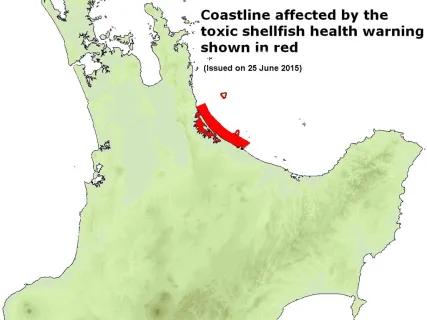Monitoring along the Bay of Plenty coastline now shows that Paralytic Shellfish Poisoning is no longer a concern for the westward portion of the Whakatāne District. Beginning in December 2014 and through late June 2015, health services have advised against consuming shellfish caught from the Whakatāne Heads and points west. These areas are now considered safe. Areas of concern do still exist in westward areas of the Bay of Plenty coastline, but our District has been given the all-clear.
The following media release from Toi Te Ora Public Health Service provides more detail.
 Regular shellfish monitoring along the coast has seen Paralytic Shellfish Poisoning (PSP) levels fall along part of the Bay of Plenty coastline.
Regular shellfish monitoring along the coast has seen Paralytic Shellfish Poisoning (PSP) levels fall along part of the Bay of Plenty coastline.
“There is now no PSP concern from Pukehina eastwards. However, the current warning remains in place from Waihi Beach to the northern end of Pukehina,” says Medical Officer of Health Dr Jim Miller.
The Medical Officer of Health continues to advise against gathering or eating shellfish from Waihi Beach, along the Bay of Plenty coast to Rogers Road, Pukehina. The warning includes Tauranga Harbour, Maketu and Waihi estuaries, Matakana and Motiti Islands, and all other islands along this coastline.
The health warning applies to all bi-valve shellfish including mussels, pipi, tuatua, cockles, oysters, scallops as well as cat’s eyes, snails and kina (sea urchin). Shellfish containing toxic levels of paralytic shellfish poison don't look or taste any different from shellfish that are safe to eat. Cooking or freezing the shellfish does not remove the toxin. Paua, crayfish and crabs can still be taken, but as always, the gut should be removed before cooking or eating.
Eating shellfish affected by paralytic shellfish toxin can cause numbness and tingling around the mouth, face, hands and feet; difficulty swallowing or breathing; dizziness; double vision; and in severe cases, paralysis and respiratory failure. These symptoms can start as soon as 1-2 hours after eating toxic shellfish and usually within 12 hours. Anyone suffering illness after eating shellfish should seek urgent medical attention.
Monitoring of toxin levels will continue along the coast and any changes in advice will be communicated accordingly. The public can obtain up-to-date information on the toxic shellfish health warning through these channels:
- Phone: 0800 221 555, option 1
- Website
- Email alerts for subscribers: www.ttophs.govt.nz/alert
- Signage at locations (i.e. shellfish health warning signs at affected beaches)